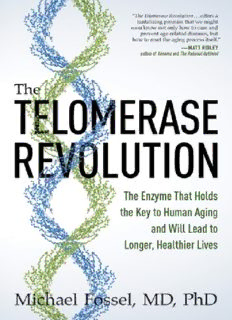
The Telomerase Revolution: The Enzyme That Holds the Key to Human Aging and Will Soon Lead to Longer, Healthier Lives PDF
Preview The Telomerase Revolution: The Enzyme That Holds the Key to Human Aging and Will Soon Lead to Longer, Healthier Lives
Praise for The Telomerase Revolution “The Telomerase Revolution is a remarkable book, telling a fascinating story that pulls together at last a single coherent theory of how and why growing old leads to so many different forms of illness. It also offers a tantalizing promise that we might soon know not only how to cure and prevent age-related diseases, but how to reset the aging process itself. Michael Fossel is a radical optimist.” —Matt Ridley, author of Genome and The Rational Optimist “The Telomerase Revolution breaks down centuries of human thought on aging and uproots outdated ideologies that have led to nothing but worthless snake oil products. Dr. Fossel’s exciting book is opening doors to extended healthspan that can change human history, and it’s all grounded in solid scientific research.” —Noel Patton, founder and chairman of T.A. Sciences “Michael Fossel’s compelling argument for the telomere approach to reversing aging isn’t just worth a look—it’s like reading the words of Virgil as he leads us along the mysteries of aging.” —Alexey Olovnikov, PhD, Institute of Biochemical Physics and Russian Academy of Sciences “Dr. Fossel has made a superb case for his belief that telomeres and telomerase play an essential role in the biology of aging both in humans and in other animals. His views were once in the minority, but more recent advances in how these molecules work have made his present book a valuable contribution to our understanding of the fundamental biology of aging. Adding to its value is that it is clearly written and well organized.” —Leonard Hayflick, PhD, Professor of Anatomy, University of California, San Francisco “Aging is not an irreversible degenerative process, but an epigenetically determined physiological mechanism, which must not be confused with age- related diseases caused by lifestyle choices. Here, we have an effective and clear guide to understanding how we get old and how to tame aging in a few years.” —Giacinto Libertini, MD, member of the Italian Society of Evolutionary Biology THE TELOMERASE REVOLUTION THE TELOMERASE REVOLUTION The Enzyme That Holds the Key to Human Aging . . . and Will Soon Lead to Longer, Healthier Lives MICHAEL FOSSEL, MD, PHD BenBella Books, Inc. Dallas, Texas To those with minds open to logic and eyes open to data: May others be as open to you as you are to the world around you. To those who, aging and suffering, hear others tell you nothing can be done: They’re wrong. Contents TELOMERE THEORY OF AGING TIMELINE INTRODUCTION CHAPTER 1 Theories of Aging The hoaxes, the myths, and the scientific theories that don’t quite account for everything CHAPTER 2 The Telomere Theory of Aging An introduction to the theory of aging this book proposes and its historical development, including a discussion of misconceptions about the theory CHAPTER 3 Why We Age A short scientific detour into the evolutionary reasons why we age rather than live indefinitely like the hydra CHAPTER 4 The Search for Immortality Applying telomere theory to clinical problems CHAPTER 5 Direct Aging: Avalanche Effects How aging cells cause disease in similar cells and tissues around them CHAPTER 6 Indirect Aging: Innocent Bystanders How aging cells cause disease in different kinds of cells and tissues CHAPTER 7 Slowing Aging What people can do now to optimize health and lifespan CHAPTER 8 Reversing Aging It’s coming soon, and it will change human lives and society in astounding ways AFTERWORD GLOSSARY INDEX ACKNOWLEDGMENTS ABOUT THE AUTHOR Telomere Theory of Aging Timeline 1665: Robert Hooke discovers that organisms are made up of cells. 1889: Charles-Édouard Brown-Séquard, a pioneer in endocrinology, claims that injected extracts of animal testis tissue (guinea pigs, dogs, monkeys) rejuvenates humans and prolongs life. 1917: Alexis Carrel begins thirty-four-year in vitro experiment with chicken-heart cells, apparently showing that individual cells are immortal. Carrel’s research becomes a scientific paradigm until it is disproven in 1961. 1930s: Serge Voronoff implants testes and ovaries of chimpanzees and monkeys in humans as anti-aging therapy. 1934: Mary Crowell and Clive McCay of Cornell University double the life expectancy of laboratory rats through severe calorie restriction. To date, this has not been definitively duplicated in humans or other primates. 1938: Hermann Muller discovers the telomere, a structure at the ends of chromosomes. 1940: Barbara McClintock describes telomeres’ function as protecting the ends of chromosomes. She later wins the Nobel Prize. 1961: Leonard Hayflick exposes the procedural error in Carrel’s experiment and introduces the concept of the Hayflick Limit, which shows that the cells of any given multicellular species divide a limited number of times before they become aged and dysfunctional (e.g., forty times in human fibroblasts).
Description: